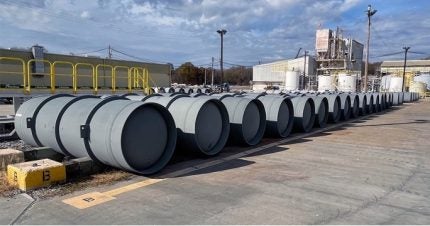
The US Department of Energy (DOE) has issued a request for proposals (RFP) to purchase low-enriched uranium (LEU) from domestic sources. This is intended to encourage the development of uranium enrichment capacity in the US, “promote diversity in the market, and provide a reliable supply of commercial nuclear fuel to support the energy security and resilience of the American people and domestic industries, free from Russian influence”.
Russia currently has about 44% of the world’s uranium enrichment capacity and supplies approximately 35% of US imports for nuclear fuel. In May, President Joe Biden signed into law a ban on Russian LEU imports that goes into effect on 11 August. To ensure US NPPs do not experience disruptions, DOE approved a process that allows the Secretary of Energy, in consultation with the Secretary of State and the Secretary of Commerce, to grant a waiver to an importer for specified quantities of Russian LEU under certain circumstances. Any waiver under this provision will terminate not later than January 2028.
This RFP is intended to spur additional domestic LEU enrichment capacity consistent with these requirements to reduce use of Russian nuclear fuel and ensure LEU demand is met through trusted sources. It is supported by $2.7bn from the President’s Investing in America agenda.
“DOE is helping jumpstart uranium enrichment capacity here in the United States, which is critical to strengthening our national security and growing our domestic nuclear industry,” said Secretary of Energy Jennifer M Granholm. “Today’s announcement underscores America’s commitment to remaining the global leader in nuclear energy for generations to come.”
Ali Zaidi, Assistant to the President and National Climate Advisor, said strengthening the domestic nuclear fuel supply chain “will be critical as we continue to move from an energy system reliant on foreign suppliers and fossil fuels to one that embraces cleaner sources of power and domestic manufacturing”.
Through the RFP, DOE will acquire LEU generated by new sources of domestic uranium enrichment capacity. These can include new enrichment facilities or projects that expand the capacity of existing enrichment facilities. DOE intends to sell the LEU to utilities operating US reactors.
New capacity can be met by either new enrichment facilities or expanded capacity at existing enrichment facilities. By limiting the proposals to new capacity, DOE believes its buying power will provide a stable customer and spur private investment in the infrastructure required to expand enrichment capacity within the US.
US-based Global Laser Enrichment welcomed the Doe initiative and said it “intends to evaluate the LEU RFP and participate in the bidding process to accelerate the commercial deployment of next-generation technology at its Paducah Laser Enrichment Facility”.
It added: “Building upon the SILEX uranium enrichment technology, GLE has the potential to supply critically needed new US capacity to produce both natural uranium (conversion) and LEU, reduce DOE’s legacy depleted uranium liability, revitalise the Western Kentucky economy, grow our North Carolina operations, and provide energy security as the US and its allies pivot from Russian supply.”
Global Laser Enrichment (GLE), jointly owned by Australia’s Silex Systems (51%) and Canada’s Cameco (49%), is the exclusive licensee of the Silex technology for uranium enrichment based on laser separation of chemical isotopes. The technology commercialisation project is being conducted at GLE’s Wilmington, North Carolina facility and at Silex’s Sydney facility.
Construction of full-scale laser and separator equipment is being deployed at GLE’s Test Loop facility in Wilmington, with the aim of completing a commercial-scale pilot demonstration of the SILEX technology by mid-2024. The next step will be construction of the Paducah Laser Enrichment Facility Multi-purpose Production Plant. The DOE’s Paducah site previously hosted the Paducah Gaseous Diffusion Plant.






